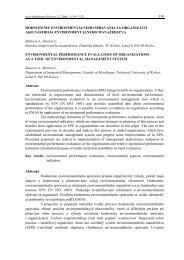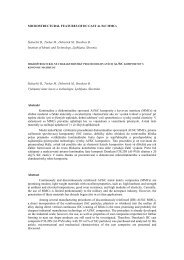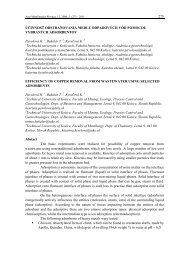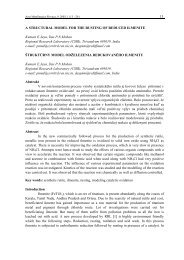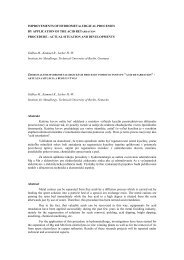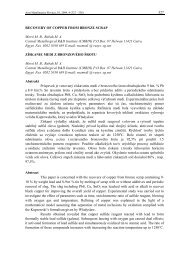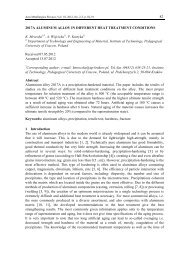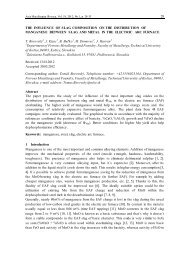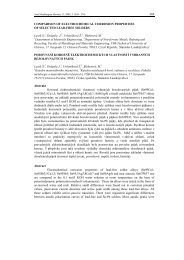the role of hydrometallurgy in the recycling of zinc, copper
the role of hydrometallurgy in the recycling of zinc, copper
the role of hydrometallurgy in the recycling of zinc, copper
Create successful ePaper yourself
Turn your PDF publications into a flip-book with our unique Google optimized e-Paper software.
THE ROLE OF HYDROMETALLURGY IN THE RECYCLING OF ZINC, COPPER AND<br />
LEAD<br />
Dutrizac J.E.,Chen T.T.<br />
Research Scientist,M<strong>in</strong><strong>in</strong>g and M<strong>in</strong>eral Sciences Laboratories,CANMET, Natural Resources<br />
Canada,555 Booth Street,Ottawa,Ontario,Canada K1A OG1<br />
ÚLOHA HYDROMETALURGIE V RECYKLÁCII ZINKU, MEDI A OLOVA<br />
Dutrizac J.E.,Chen T.T.<br />
Research Scientist,M<strong>in</strong><strong>in</strong>g and M<strong>in</strong>eral Sciences Laboratories,CANMET, Natural Resources<br />
Canada,555 Booth Street,Ottawa,Ontario,Canada K1A OG1<br />
Abstrakt<br />
Recyklácia kovov ostáva významnou <strong>in</strong>dustriálnou aktivitou a to tak z ekonomických ako aj<br />
environmentálnych dôvodov. V tomto príspevku je diskutovaná úloha hydrometalurgie pri recyklácii<br />
z<strong>in</strong>ku, medi a olova. Boli vyv<strong>in</strong>uté hydrometalurgické procesy na odlúhovanie z<strong>in</strong>ku z galvanicky<br />
pokoveného šrotu pred tavením, a takisto alkalické ako aj kyslé lúhovacie techniky za účelom<br />
odstránenia z<strong>in</strong>ku z prachu pochádzajúceho z elektrických oblúkových pecí pred jeho recykláciou.<br />
Vysoké obsahy halogenidov v prachoch nasvedčujú, že procesy ako EZIMEX alebo Terra Gaia<br />
založené na chloridových systémoch môžu byť obzvlášť vhodné pre tento typ materiálov. Väčš<strong>in</strong>a<br />
medenného šrotu je pretavená, ohňovo raf<strong>in</strong>ovaná a odlievaná do anód pre elektroraf<strong>in</strong>áciu.<br />
Pochopenie chovania sa rôznorodých nečistôt prítomných v medenných anódach pripravených zo<br />
sekundárnych materiálov a ich riadený prechod do anódového kalu tvoriaceho sa počas elektroraf<strong>in</strong>ácie<br />
sú kritickým parametrom pri výrobe vysokokvalitnej katódovej medi. Hydrometalurgia hrá významnú<br />
úlohu pri spracovaní kalu pochádzajúceho z použitých olovených akumulátorov; karbonátové<br />
lúhovanie je široko používané pri elim<strong>in</strong>ácii sulfátovej frakcie kalu, čím sa podarí vyhnúť emisii SO_ 2<br />
pri následnom pretavovaní olova. Úloha hydrometalurgie môže byť ďalej rozšírená, ak sa podarí<br />
vyv<strong>in</strong>úť stabilné anódy umožňujúce komerčnú implementáciu mnohých vyvíjaných elektrolúhovacích<br />
procesov pre spracovanie kalu z olovených akumulátorov.<br />
Abstract<br />
Metals recycl<strong>in</strong>g rema<strong>in</strong>s an important <strong>in</strong>dustrial activity for both economic and<br />
environmental reasons, and <strong>the</strong> <strong>role</strong> <strong>of</strong> hydrometallurgical process<strong>in</strong>g <strong>in</strong> <strong>the</strong> recycl<strong>in</strong>g <strong>of</strong> z<strong>in</strong>c, <strong>copper</strong><br />
and lead is discussed. Hydrometallurgical processes are be<strong>in</strong>g developed to leach z<strong>in</strong>c from galvanized<br />
steel scrap prior to remelt<strong>in</strong>g, and both alkal<strong>in</strong>e and acid leach<strong>in</strong>g technologies are be<strong>in</strong>g evaluated to<br />
elim<strong>in</strong>ate z<strong>in</strong>c from electric arc furnace (EAF) dusts prior to <strong>the</strong>ir recycle. The high halogen content <strong>of</strong><br />
<strong>the</strong> dusts, however, suggests that chloride-based systems, such as <strong>the</strong> EZINEX or Terra Gaia processes,<br />
could be especially useful for this material. Most <strong>copper</strong> scrap is melted, fire ref<strong>in</strong>ed and cast <strong>in</strong>to<br />
anodes for electroref<strong>in</strong><strong>in</strong>g. An understand<strong>in</strong>g <strong>of</strong> <strong>the</strong> behaviour <strong>of</strong> <strong>the</strong> diverse impurities present <strong>in</strong><br />
secondary <strong>copper</strong> anodes and <strong>the</strong>ir controlled rejection to <strong>the</strong> anode slimes generated dur<strong>in</strong>g<br />
electroref<strong>in</strong><strong>in</strong>g are critical to <strong>the</strong> production <strong>of</strong> high quality cathode <strong>copper</strong>. Hydrometallurgy plays an<br />
important <strong>role</strong> <strong>in</strong> <strong>the</strong> treatment <strong>of</strong> <strong>the</strong> paste component <strong>of</strong> spent lead-acid batteries; a carbonate leach is<br />
widely used to elim<strong>in</strong>ate <strong>the</strong> sulphate fraction <strong>of</strong> <strong>the</strong> paste, <strong>the</strong>reby avoid<strong>in</strong>g SO 2 gas emissions <strong>in</strong>
subsequent smelt<strong>in</strong>g operations. The <strong>role</strong> <strong>of</strong> <strong>hydrometallurgy</strong> could be expanded if stable anodes could<br />
be developed to allow commercial implementation <strong>of</strong> <strong>the</strong> many leach-electrow<strong>in</strong>n<strong>in</strong>g processes under<br />
development for lead-acid battery paste.<br />
Introduction<br />
Metals such as iron, <strong>copper</strong> and lead have been produced s<strong>in</strong>ce antiquity, and because <strong>of</strong> <strong>the</strong>ir<br />
high <strong>in</strong>herent value, <strong>the</strong>y have always been extensively recycled. The early recycl<strong>in</strong>g practices were<br />
based on pyrometallurgical techniques, such as re-forg<strong>in</strong>g and remelt<strong>in</strong>g, to try to realize <strong>the</strong> maximum<br />
value from <strong>the</strong> metal which was produced <strong>in</strong>itially at a very high relative cost because <strong>of</strong> <strong>the</strong> low<br />
productivity <strong>of</strong> <strong>the</strong> manual labour used. The modern age has seen <strong>the</strong> greatly expanded production <strong>of</strong><br />
<strong>the</strong> traditional metals and <strong>the</strong> growth <strong>of</strong> new metals such as nickel, alum<strong>in</strong>um and magnesium. The<br />
relative value <strong>of</strong> all metals has decreased dramatically because <strong>of</strong> mechanized production methods; <strong>in</strong><br />
some <strong>in</strong>stances, metals have become a „throw-away“ commodity, a situation which would have been<br />
unth<strong>in</strong>kable even a century ago. Despite <strong>the</strong> significant decl<strong>in</strong>e <strong>in</strong> <strong>the</strong> relative value <strong>of</strong> metals, <strong>the</strong>ir<br />
recycl<strong>in</strong>g rema<strong>in</strong>s an important aspect <strong>of</strong> modern society. Although metals recycl<strong>in</strong>g is <strong>of</strong>ten carried<br />
out for economic reasons, <strong>in</strong>creas<strong>in</strong>gly, recycl<strong>in</strong>g is done because <strong>of</strong> environmental or hygiene<br />
considerations.<br />
Table 1 lists five tonnage metals and <strong>the</strong>ir 1995 production levels. Iron/steel is by far <strong>the</strong> most<br />
common metal <strong>in</strong> modern society, and its annual output greatly exceeds that <strong>of</strong> all o<strong>the</strong>r metals<br />
comb<strong>in</strong>ed. Alum<strong>in</strong>um, <strong>copper</strong>, z<strong>in</strong>c and lead are <strong>the</strong> most commonly produced non-ferrous metals;<br />
<strong>the</strong>ir comb<strong>in</strong>ed output exceeds that <strong>of</strong> <strong>the</strong> o<strong>the</strong>r non-ferrous metals. For example, <strong>the</strong> production <strong>of</strong><br />
nickel is about 900,000 t/y, and that <strong>of</strong> magnesium, a growth metal, is only about 250,000 t/y. Hence,<br />
from a recycl<strong>in</strong>g po<strong>in</strong>t <strong>of</strong> view, <strong>the</strong> behaviour <strong>of</strong> <strong>the</strong> five metals shown <strong>in</strong> Table 1 is <strong>of</strong> paramount<br />
importance. The deportment <strong>of</strong> o<strong>the</strong>r metals, like cadmium or nickel, may have important<br />
ramifications from a hygiene or toxicological perspective, but <strong>the</strong>y are <strong>of</strong> m<strong>in</strong>or importance with<br />
respect to <strong>the</strong> overall tonnage <strong>of</strong> metals recycled.<br />
Table 1 Annual production <strong>of</strong> five major metals<br />
Metal<br />
Production (t/y)<br />
Iron/steel 700,000,000<br />
Alum<strong>in</strong>um 20,000,000<br />
Copper 12,000,000<br />
Z<strong>in</strong>c 7,000,000<br />
Lead 5,000,000<br />
The metals listed <strong>in</strong> Table 1 are all recycled, and <strong>the</strong> relative contribution <strong>of</strong> recycled metal to total<br />
production ranges from ~60% for lead to ~15% for z<strong>in</strong>c. Despite <strong>the</strong> recent advances made <strong>in</strong><br />
<strong>hydrometallurgy</strong> and <strong>the</strong> great selectivity <strong>of</strong> hydrometallurgical systems, most metal recycl<strong>in</strong>g is still<br />
based on pyrometallurgical techniques. For reactive metals such as alum<strong>in</strong>um, melt<strong>in</strong>g and molten<br />
metal ref<strong>in</strong><strong>in</strong>g are used to conserve <strong>the</strong> high energy content <strong>of</strong> <strong>the</strong> metallic phase. For less reactive<br />
metals like <strong>copper</strong>, smelt<strong>in</strong>g allows <strong>the</strong> collection and concentration <strong>of</strong> <strong>the</strong> metal <strong>in</strong> a form convenient<br />
for fur<strong>the</strong>r ref<strong>in</strong><strong>in</strong>g. Never<strong>the</strong>less, hydrometallurgical techniques are important <strong>in</strong> <strong>the</strong> overall recycl<strong>in</strong>g<br />
<strong>of</strong> some metals, and this importance will likely <strong>in</strong>crease as new technologies are developed. With<strong>in</strong><br />
this framework, this paper discusses <strong>the</strong> <strong>role</strong> <strong>of</strong> <strong>hydrometallurgy</strong> <strong>in</strong> <strong>the</strong> recycl<strong>in</strong>g <strong>of</strong> z<strong>in</strong>c, <strong>copper</strong> and
lead; it also presents some recent experimental work focused on <strong>the</strong> use <strong>of</strong> <strong>hydrometallurgy</strong> <strong>in</strong> <strong>the</strong><br />
overall recycl<strong>in</strong>g <strong>of</strong> <strong>the</strong>se metals.<br />
THE RECYCLING OF ZINC, COPPER AND LEAD<br />
Z<strong>in</strong>c-bear<strong>in</strong>g Steel Plant Dusts<br />
Although several thousand tonnes <strong>of</strong> scrap steel are used annually for cementation reactions or<br />
<strong>the</strong> generation <strong>of</strong> iron salts for water treatment, most iron and steel is simply remelted, commonly <strong>in</strong><br />
electric arc furnaces (EAF) or <strong>in</strong> basic oxygen furnaces (BOF). The presence <strong>of</strong> galvanized steel <strong>in</strong> <strong>the</strong><br />
scrap results <strong>in</strong> process dusts which are z<strong>in</strong>c-bear<strong>in</strong>g and cannot, <strong>the</strong>refore, be recycled with<strong>in</strong> <strong>the</strong> steel<br />
plant. There are two general approaches to overcome <strong>the</strong> problems caused by <strong>the</strong> presence <strong>of</strong> z<strong>in</strong>c.<br />
The first attempts to remove z<strong>in</strong>c from <strong>the</strong> steel scrap before it is melted, whereas <strong>the</strong> second, and more<br />
common method, is to elim<strong>in</strong>ate <strong>the</strong> z<strong>in</strong>c from <strong>the</strong> dust prior to its recycle.<br />
Early work on <strong>the</strong> removal <strong>of</strong> z<strong>in</strong>c coat<strong>in</strong>gs from scrap steel focused on sulphuric acid<br />
leach<strong>in</strong>g [1]. Significant z<strong>in</strong>c recoveries, however, were realized only at low pH’s where extensive iron<br />
dissolution also occurred. More promis<strong>in</strong>g is <strong>the</strong> use <strong>of</strong> sodium hydroxide solutions which readily<br />
dissolve z<strong>in</strong>c, lead and alum<strong>in</strong>um while leav<strong>in</strong>g <strong>the</strong> steel largely unaffected. This option is be<strong>in</strong>g tested<br />
<strong>in</strong> a 48,000 t/y pilot plant operated by Metal Recovery Industries (MRI) [2]. The process was orig<strong>in</strong>ally<br />
based on <strong>the</strong> anodically accelerated leach<strong>in</strong>g <strong>of</strong> ei<strong>the</strong>r 730 kg scrap bundles or shredded scrap. The<br />
published data suggest that <strong>the</strong> electrical energy requirements and <strong>the</strong> residence times <strong>in</strong>crease as <strong>the</strong><br />
size <strong>of</strong> <strong>the</strong> bundles <strong>in</strong>creases. The process is more effective on shredded scrap, and presently, no<br />
anodic current is applied when loose shredded scrap is leached. Figure 1 shows <strong>the</strong> various process<strong>in</strong>g<br />
steps, and it is important to recognize that a simple rotary drum is now used for <strong>the</strong> caustic leach<strong>in</strong>g<br />
operation. The leach<strong>in</strong>g process is carried out for ~2 h at 85°C <strong>in</strong> 5-10 M NaOH solution to remove up<br />
to 99% <strong>of</strong> <strong>the</strong> conta<strong>in</strong>ed z<strong>in</strong>c. The de-z<strong>in</strong>ced scrap is washed, and <strong>the</strong> washed scrap typically conta<strong>in</strong>s<br />
0.01-0.02% Zn and 0.001-0.05% Na. It is readily recyclable with<strong>in</strong> <strong>the</strong> steel <strong>in</strong>dustry. The sodium<br />
z<strong>in</strong>cate solution is purified with z<strong>in</strong>c dust to remove Fe, Pb, Cu and Ni and is <strong>the</strong>n electrowon with a<br />
current efficiency <strong>of</strong> ~90%. The z<strong>in</strong>c is produced as a f<strong>in</strong>e dendritic powder [3] which can be melted<br />
under a suitable flux with a melt<strong>in</strong>g loss <strong>of</strong> about 10%. Various direct applications <strong>of</strong> <strong>the</strong> particulate<br />
z<strong>in</strong>c are be<strong>in</strong>g explored. The cost <strong>of</strong> <strong>the</strong> process is estimated at ~U.S. $35/t steel treated, when a credit<br />
for <strong>the</strong> by-product z<strong>in</strong>c is <strong>in</strong>cluded. The cost is significant, however, when <strong>the</strong> low Zn content <strong>of</strong> <strong>the</strong><br />
steel is considered, and <strong>of</strong> course, elim<strong>in</strong>ation <strong>of</strong> <strong>the</strong> z<strong>in</strong>c does not elim<strong>in</strong>ate <strong>the</strong> EAF or BOF dusts, but<br />
only alters <strong>the</strong>ir compositions.<br />
A more common approach is to treat <strong>the</strong> steel plant dust itself, and <strong>in</strong> this regard, Table 2<br />
presents <strong>the</strong> range <strong>of</strong> compositions <strong>of</strong> <strong>the</strong> 1,400,000 t <strong>of</strong> EAF dust which are generated annually <strong>in</strong> <strong>the</strong><br />
steel <strong>in</strong>dustry [4]. The EAF dusts are treated commercially by pyrometallurgical methods such as waelz<br />
kilns, electro<strong>the</strong>rmic furnaces, Imperial Smelt<strong>in</strong>g furnaces or flame reactors. Several plasma-based<br />
processes have also been applied to EAF dusts, but it is believed that all <strong>the</strong> plasma-based processes<br />
have ceased operation because <strong>of</strong> technical problems and high costs. All <strong>the</strong> pyrometallurgical options<br />
yield a leady ZnO product rich <strong>in</strong> halogens. Because <strong>of</strong> its impurity content, <strong>the</strong> ZnO has not yet found<br />
direct application <strong>in</strong> <strong>the</strong> primary z<strong>in</strong>c <strong>in</strong>dustry where its neutraliz<strong>in</strong>g capabilities would be an obvious<br />
benefit.<br />
Fig.1 Schematic flowsheet <strong>of</strong> <strong>the</strong> MRI process for steel scrap (Ref.2)<br />
Table 2 Compositional range <strong>of</strong> EAF dust (wt %)<br />
Element<br />
Fe 20-40<br />
Compositional Range
Zn 10-30<br />
Pb 1-4<br />
Cl 0.5-3<br />
F 0.1-0.5<br />
Cu 0.1-0.3<br />
Cd 0.02-0.1<br />
A number <strong>of</strong> hydrometallurgical processes have also been developed to treat steel plant dusts.<br />
Early efforts were directed towards conventional H 2 SO 4 -based technologies. Those processes failed<br />
because <strong>of</strong> <strong>the</strong> high Fe/Zn ratio <strong>of</strong> <strong>the</strong> EAF dusts, and especially because <strong>of</strong> <strong>the</strong> high halogen content<br />
which cannot be accommodated dur<strong>in</strong>g z<strong>in</strong>c sulphate electrolysis. Alkal<strong>in</strong>e leach<strong>in</strong>g <strong>of</strong>fers <strong>the</strong><br />
potential advantage that iron rema<strong>in</strong>s largely <strong>in</strong>soluble, and efforts to develop alkal<strong>in</strong>e leach<strong>in</strong>g<br />
technologies for EAF dusts cont<strong>in</strong>ue. Such processes are limited, however, by <strong>the</strong>ir <strong>in</strong>ability to recover<br />
z<strong>in</strong>c from z<strong>in</strong>c ferrite unless a reduc<strong>in</strong>g roast is first carried out [5]. Both approaches result <strong>in</strong> halideconta<strong>in</strong><strong>in</strong>g<br />
solutions, <strong>the</strong> process<strong>in</strong>g <strong>of</strong> which is difficult. Because <strong>of</strong> <strong>the</strong> high chloride content <strong>of</strong> EAF<br />
dusts, chloride-based process<strong>in</strong>g technologies could <strong>of</strong>fer several advantages over H 2 SO 4 or NaOH<br />
process<strong>in</strong>g media. Hence, much <strong>of</strong> <strong>the</strong> recent hydrometallurgical activity related to <strong>the</strong> treatment <strong>of</strong><br />
steel plant dusts has centered on chloride-based leach<strong>in</strong>g systems.<br />
The Z<strong>in</strong>cex process [6,7] was orig<strong>in</strong>ally developed to recover z<strong>in</strong>c from <strong>the</strong> chloride-sulphate<br />
solutions generated dur<strong>in</strong>g <strong>the</strong> leach<strong>in</strong>g <strong>of</strong> roasted pyrite ore. Those solutions conta<strong>in</strong>ed about 2 M Cl<br />
and 20-30 g/L Zn which was present as various Zn-Cl complexes. The Zn-Cl complexes were<br />
extracted us<strong>in</strong>g a secondary am<strong>in</strong>e, and <strong>the</strong> loaded organic was stripped with water to give an aqueous<br />
chloride solution conta<strong>in</strong><strong>in</strong>g Zn <strong>in</strong> <strong>the</strong> cationic form. The dissolved Zn was next extracted us<strong>in</strong>g<br />
DEHPA at pH 2.5, and <strong>the</strong> pH was kept constant by <strong>the</strong> addition <strong>of</strong> a lime slurry to <strong>the</strong> mixer-settlers.<br />
The loaded z<strong>in</strong>c was stripped with H 2 SO 4 to yield a 90 g/L Zn sulphate solution suitable for<br />
conventional z<strong>in</strong>c electrolysis. As shown <strong>in</strong> Figure 2, <strong>the</strong> system effectively separates Zn from <strong>the</strong><br />
chloride contam<strong>in</strong>ant, but <strong>of</strong> course, creates a chloride solution which must be fur<strong>the</strong>r processed prior<br />
to discharge.<br />
Fig.2 Use <strong>of</strong> <strong>the</strong> Z<strong>in</strong>cex process to convert z<strong>in</strong>c from a chloride-conta<strong>in</strong><strong>in</strong>g solution to an all-sulphate medium (Ref.7)<br />
As applied to EAF dust, <strong>the</strong> approach is to leach <strong>the</strong> dust <strong>in</strong> dilute sulphuric acid to solubilize <strong>the</strong> ZnO<br />
component which is <strong>the</strong>n treated directly by DEPHA solvent extraction. The result<strong>in</strong>g leach residue can<br />
be treated by hot br<strong>in</strong>e leach<strong>in</strong>g to solubilize Pb and Ag prior to its recycle or discard. The f<strong>in</strong>al<br />
residue from <strong>the</strong> leach<strong>in</strong>g <strong>of</strong> <strong>the</strong> EAF dust likely will conta<strong>in</strong> some gypsum <strong>in</strong> addition to z<strong>in</strong>c ferrite.<br />
The presence <strong>of</strong> both Zn and SO 4 <strong>in</strong> <strong>the</strong> residue makes its recycle more difficult. The use <strong>of</strong> dilute<br />
HCL for <strong>the</strong> <strong>in</strong>itial leach might simplify <strong>the</strong> overall flowsheet as applied to EAF dust.<br />
A more recent development <strong>in</strong> <strong>the</strong> EZINEX process <strong>of</strong> Engitec Impianti [8,9] that is shown<br />
schematically <strong>in</strong> Figure 3. In this process, EAF dust is leached for 1 h at 70-80°C <strong>in</strong> an ammonium<br />
chloride-alkali chloride solution. The ZnO <strong>in</strong> <strong>the</strong> EAF dust is readily solubilized:<br />
ZnO + 2NH 4 Cl → Zn(NH 3 ) 2 Cl 2 + H 2 O (1)<br />
Although ZnO is readily dissolved, z<strong>in</strong>c ferrite is not appreciably attacked. After liquid-solids<br />
separation, <strong>the</strong> solution is treated with z<strong>in</strong>c dust to cement out Pb, Cu and Cd. The result<strong>in</strong>g solution<br />
typically conta<strong>in</strong>s 31-36 g/L Zn and
Zn(NH 3 ) 2<br />
2+ + 2e - → Zn + 2NH 3 (2)<br />
2Cl - → Cl 2 + 2e - (3)<br />
Cl 2 + 2/3NH3 → 2Cl - + 2H + + 1/3N 2 (4)<br />
Zn(NH 3 ) 2 Cl 2 + 2/3NH 3 → Zn + 2NH 4 Cl + 1/3N 2 (5)<br />
Hence, <strong>the</strong> chloride ion acts as a catalyst for <strong>the</strong> oxidation <strong>of</strong> ammonia to N 2 gas. The electrolysis cell<br />
operates at 200 A/m 2 and employs graphite anodes and titanium cathode plat<strong>in</strong>g blanks fitted with air<br />
spargers to enhance mass transport at <strong>the</strong> cathode. A compact, easily strippable Zn deposit is obta<strong>in</strong>ed.<br />
Fig.3 Use <strong>of</strong> <strong>the</strong> EZINEX process to treat EAF dust (Ref.8)<br />
The leached EAF dust conta<strong>in</strong>s all <strong>the</strong> z<strong>in</strong>c ferrite which was orig<strong>in</strong>ally present. This residue<br />
is mixed with coal and is dried prior to be<strong>in</strong>g recycled to <strong>the</strong> electric arc furnace. When <strong>the</strong> EAF dust<br />
was recycled at a rate <strong>of</strong> 1% <strong>of</strong> <strong>the</strong> furnace charge, all <strong>the</strong> Zn present <strong>in</strong> <strong>the</strong> ferrite was fumed, and<br />
about 70% <strong>of</strong> <strong>the</strong> recycled iron units were recovered <strong>in</strong> <strong>the</strong> molten steel. It is claimed that exhaustive<br />
recycl<strong>in</strong>g tests have been carried out at Ferriere Nord <strong>in</strong> Ud<strong>in</strong>e, Italy, and that no significant<br />
accumulation <strong>of</strong> impurities occurs <strong>in</strong> ei<strong>the</strong>r <strong>the</strong> EAF dust or <strong>the</strong> steel. The implication is that <strong>the</strong><br />
complete removal <strong>of</strong> all <strong>of</strong> <strong>the</strong> impurities <strong>in</strong> <strong>the</strong> leach<strong>in</strong>g step is not required; it is only necessary to<br />
effect a significant bleed <strong>of</strong> Zn, Pb, Cu, etc. This is an important observation which could affect <strong>the</strong><br />
development <strong>of</strong> o<strong>the</strong>r hydrometallurgical processes for EAF dusts. The EZINEX process requires only<br />
a small bleed <strong>of</strong> alkali and alkal<strong>in</strong>e earth chloride salts, which can be recrystallized without a<br />
significant loss <strong>of</strong> <strong>the</strong> more soluble ammonium chloride. The EZINEX process has been extensively<br />
tested <strong>in</strong> a 500 t/y pilot plant facility and it is reported that a commercial plant is be<strong>in</strong>g <strong>in</strong>stalled at<br />
Ferriere Nord <strong>in</strong> Ud<strong>in</strong>e, Italy.<br />
A somewhat similar process was developed by Hoogovens Ijmuiden and Delft University <strong>of</strong><br />
Technology [10,11] for <strong>the</strong> treatment <strong>of</strong> z<strong>in</strong>c-bear<strong>in</strong>g blast furnace dust. This product differs from EAF<br />
dust <strong>in</strong> that z<strong>in</strong>c ferrite is largely absent. In <strong>the</strong> proposed process, shown schematically <strong>in</strong> Figure 4, <strong>the</strong><br />
dust is leached under oxidiz<strong>in</strong>g conditions at 125-140°C <strong>in</strong> hydrochloric acid or <strong>in</strong> ferrous chlorideconta<strong>in</strong><strong>in</strong>g<br />
spent pickle liquor.<br />
Fig.4 Chloride-based leach<strong>in</strong>g system for <strong>the</strong> treatment <strong>of</strong> z<strong>in</strong>c-bear<strong>in</strong>g blast furnace dust (Ref.11)<br />
The z<strong>in</strong>c and lead are readily dissolved, but only m<strong>in</strong>or iron leach<strong>in</strong>g occurs. The limited amount <strong>of</strong><br />
iron dissolution is achieved by controll<strong>in</strong>g <strong>the</strong> solution pH to limit <strong>the</strong> attack <strong>of</strong> <strong>the</strong> iron oxides and by<br />
operat<strong>in</strong>g <strong>the</strong> leach autoclave at a sufficiently high O 2 pressure and temperature that iron oxidationhydrolysis<br />
occurs. As was <strong>the</strong> case for <strong>the</strong> EZINEX process, <strong>the</strong> iron-rich residue is filtered and<br />
recycled to <strong>the</strong> steel plant. In this regard, it should be noted that <strong>the</strong> extractions <strong>of</strong> both Zn and Pb from<br />
<strong>the</strong> dust exceed 95%. The solubilized Pb is precipitated as an oxide by <strong>the</strong> addition <strong>of</strong> NaOCl and<br />
f<strong>in</strong>ely ground limestone. Next, chloride-free (
conventional water treatment facility. As a general observation, <strong>the</strong> recovery <strong>of</strong> potentially marketable<br />
Zn and Pb products and <strong>the</strong> recycle <strong>of</strong> <strong>the</strong> important iron units conta<strong>in</strong>ed <strong>in</strong> <strong>the</strong> blast furnace dust are<br />
positive features <strong>of</strong> this type <strong>of</strong> hydrometallurgical process.<br />
The Terra Gaia process is based on <strong>the</strong> dissolution <strong>of</strong> both ZnO and ZnFe 2 O 4 <strong>in</strong> FeCl 3 -HCl<br />
media at 175°C [13], as is illustrated <strong>in</strong> <strong>the</strong> flowsheet given <strong>in</strong> Figure 5. The EAF dust is stirred with a<br />
ferrous chloride solution, made by react<strong>in</strong>g scrap iron with Cl 2 gas, and is <strong>the</strong>n <strong>in</strong>jected <strong>in</strong>to an<br />
autoclave at 175°C. Oxygen is also <strong>in</strong>jected with <strong>the</strong> result that <strong>the</strong> FeCl 2 is oxidized to FeCl 3 which<br />
hydrolyzes extensively at 175°C:<br />
2FeCl 2 + 1/2O 2 + 2H 2 O → Fe 2 O 3 + 4HCl (6)<br />
The generated hydrochloric acid attacks both <strong>the</strong> ZnO and ZnFe 2 O 4 constituents, and any residual<br />
FeCl 3 reacts rapidly with <strong>the</strong> ZnO:<br />
2FeCl 3 + 3ZnO + H 2 O → 2FeOOH + 3ZnCl 2 (7)<br />
2FeOOH → Fe 2 O 3 + H 2 O (8)<br />
Presumably, <strong>the</strong> abundant Fe 2 O 3 <strong>in</strong> <strong>the</strong> EAF dust passes through <strong>the</strong> autoclave largely unaffected.<br />
Prelim<strong>in</strong>ary test work has shown that Zn and Pb extractions consistently exceed 98% and that <strong>the</strong><br />
result<strong>in</strong>g hematite residue can be recycled with<strong>in</strong> a steel plant or safely discarded.<br />
Fig.5 Schematic flowsheet <strong>of</strong> <strong>the</strong> Terra Gaia process for <strong>the</strong> treatment <strong>of</strong> EAF dust (Ref.13)<br />
Recent fundamental studies done at CANMET [14] have helped to clarify <strong>the</strong> behaviour <strong>of</strong><br />
FeCl 3 solutions at elevated temperatures. In this regard, Figure 6 shows <strong>the</strong> composition <strong>of</strong> <strong>the</strong><br />
precipitates made at various temperatures when 0.3 M FeCl 3 solutions were heated for 3 h <strong>in</strong> <strong>the</strong><br />
absence <strong>of</strong> hematite seed. At temperatures
2FeCl 3 + 3H 2 O ⇔ Fe 2 O 3 + 6HCl (9)<br />
This is an important observation relative to <strong>the</strong> chloride leach<strong>in</strong>g <strong>of</strong> EAF dusts at high temperatures<br />
because it means that <strong>the</strong> system is self-buffer<strong>in</strong>g with respect to acid concentration. If too much acid<br />
is present, some <strong>of</strong> <strong>the</strong> abundant hematite will dissolve to make FeCl 3 . Conversely, if too little acid is<br />
present, FeCl 3 will hydrolyze to generate sufficient acid to allow <strong>the</strong> dissolution <strong>of</strong> additional ferrites<br />
present <strong>in</strong> <strong>the</strong> EAF dust.<br />
Fig.7 Effect <strong>of</strong> acid/base concentration on <strong>the</strong> amount <strong>of</strong> hematite precipitated from FeCl 3 media<br />
The hematite made from chloride media <strong>in</strong>corporates a modest amount <strong>of</strong> Cl but only<br />
negligible amounts <strong>of</strong> Zn. For example, <strong>the</strong> precipitate made at 150 °C conta<strong>in</strong>s 67-68% Fe, ~0.2% Cl<br />
and only 0.03% Zn. It is believed that such material could be recycled without difficulty <strong>in</strong> a steel<br />
plant. Of course, <strong>the</strong> recovery <strong>of</strong> Zn and Pb from <strong>the</strong> process<strong>in</strong>g solution would be required, and <strong>in</strong> <strong>the</strong><br />
Terra Gaia process, it is proposed to precipitate <strong>the</strong>se metals as sulphides. It is also proposed to discard<br />
<strong>the</strong> result<strong>in</strong>g br<strong>in</strong>e, but clearly this practice is site-specific.<br />
Hydrometallury <strong>in</strong> <strong>the</strong> Recycl<strong>in</strong>g <strong>of</strong> Copper<br />
The hydrometallurgical treatment <strong>of</strong> <strong>copper</strong> ores and concentrates is highly developed and<br />
accounts for approximately 20% <strong>of</strong> <strong>the</strong> world’s primary <strong>copper</strong> production. The key to <strong>the</strong> success <strong>of</strong><br />
<strong>the</strong> hydrometallurgical route has been <strong>the</strong> development <strong>of</strong> solvent extraction reagents which can<br />
selectively recover Cu from dilute leach solutions. The loaded extractants are <strong>the</strong>n stripped by<br />
sulphuric acid to yield a solution suitable for electrolysis to high purity metal. O<strong>the</strong>r positive factors<br />
have been <strong>the</strong> extensive automation <strong>of</strong> <strong>the</strong> ref<strong>in</strong>eries to lower process<strong>in</strong>g costs and a better<br />
understand<strong>in</strong>g <strong>of</strong> <strong>the</strong> leach<strong>in</strong>g reactions to maximize <strong>copper</strong> extractions. Several efforts have been<br />
made to extend this hydrometallurgical expertise to <strong>the</strong> recycl<strong>in</strong>g <strong>of</strong> <strong>copper</strong> metal, ei<strong>the</strong>r by a leachelectrow<strong>in</strong>n<strong>in</strong>g<br />
approach or by direct electroref<strong>in</strong><strong>in</strong>g <strong>of</strong> scrap <strong>in</strong> „baskets“. Generally, such efforts have<br />
not been economically successful. Despite <strong>the</strong> great success <strong>of</strong> <strong>hydrometallurgy</strong> <strong>in</strong> <strong>the</strong> primary <strong>copper</strong><br />
<strong>in</strong>dustry, pyrometallurgy rema<strong>in</strong>s <strong>the</strong> dom<strong>in</strong>ant tool <strong>in</strong> <strong>the</strong> recycl<strong>in</strong>g <strong>of</strong> <strong>copper</strong> metal.<br />
By way <strong>of</strong> illustration, Table 3 shows <strong>the</strong> ultimate dest<strong>in</strong>ation <strong>of</strong> various types <strong>of</strong> <strong>copper</strong> scrap<br />
<strong>in</strong> North America. High grade scrap, consist<strong>in</strong>g <strong>of</strong> almost pure <strong>copper</strong> metal, is used directly for <strong>the</strong><br />
manufacture <strong>of</strong> brass and bronze. This material is simply melted and alloyed to <strong>the</strong> appropriate<br />
composition. Any impurities present can be tolerated with<strong>in</strong> <strong>the</strong> specifications <strong>of</strong> <strong>the</strong> alloy, or are<br />
significantly diluted by blend<strong>in</strong>g. Slightly lower grade material is processed <strong>in</strong> <strong>copper</strong> ref<strong>in</strong>eries,<br />
where it is blended, melted and cast <strong>in</strong>to anodes. Lower grade material is commonly processed <strong>in</strong> small<br />
shaft furnaces, with or without a convert<strong>in</strong>g step. The result<strong>in</strong>g <strong>in</strong>gots <strong>of</strong> black <strong>copper</strong> can be fire<br />
ref<strong>in</strong>ed or sold to <strong>copper</strong> smelters for addition to <strong>the</strong> converters as cold dope. Still lower grade material<br />
is commonly processed <strong>in</strong> <strong>copper</strong> smelters, and <strong>the</strong> cut-<strong>of</strong>f <strong>copper</strong> grade is strongly dependent on <strong>the</strong><br />
impurity or precious metal contents <strong>of</strong> <strong>the</strong> scrap. The important observation, however, is that all <strong>the</strong><br />
<strong>copper</strong> is treated, at least <strong>in</strong>itially, by pyrometallurgical methods to yield ei<strong>the</strong>r a marketable product or<br />
anodes for electroref<strong>in</strong><strong>in</strong>g. When <strong>the</strong> scrap <strong>copper</strong> is processed <strong>in</strong> a primary smelter, it is so diluted that<br />
<strong>the</strong> anodes behave essentially like primary <strong>copper</strong> anodes. When <strong>the</strong> <strong>copper</strong> is processed <strong>in</strong> a secondary<br />
ref<strong>in</strong>ery, however, <strong>the</strong> result<strong>in</strong>g anodes are materially different, and <strong>the</strong>ir behaviour dur<strong>in</strong>g aqueous<br />
electroref<strong>in</strong><strong>in</strong>g may be significantly different, from those cast <strong>in</strong> a primary smelter.
Table 3 Copper recycl<strong>in</strong>g <strong>in</strong> North America<br />
Type <strong>of</strong> Recycler Tonnage Treated Typical Copper Content (wt %)<br />
Brass Mills 600,000 99.8<br />
Primary or Secondary<br />
Copper Ref<strong>in</strong>eries 430,000 96<br />
Ingot Makers 270,000 70<br />
Copper Smelters 250,000 25-35<br />
The behaviour <strong>of</strong> various k<strong>in</strong>ds <strong>of</strong> anodes dur<strong>in</strong>g <strong>copper</strong> electroref<strong>in</strong><strong>in</strong>g is <strong>of</strong> relevance to <strong>the</strong><br />
<strong>in</strong>dustry, and has been an on-go<strong>in</strong>g research activity at CANMET for a number <strong>of</strong> years. Although<br />
<strong>the</strong>re are no secondary <strong>copper</strong> ref<strong>in</strong>eries <strong>in</strong> Canada, CANMET recently carried out detailed studies <strong>of</strong><br />
<strong>the</strong> secondary anodes and anode slimes generated at <strong>the</strong> Copper Division <strong>of</strong> Southwire <strong>in</strong> <strong>the</strong> United<br />
States and at Huttenwerke Kaiser <strong>in</strong> Germany. Table 4 presents <strong>the</strong> compositions <strong>of</strong> two <strong>of</strong> <strong>the</strong> anodes<br />
studied. Relative to <strong>the</strong> anodes processed <strong>in</strong> primary operations, both anodes are notably deficient <strong>in</strong><br />
Se, Te and Bi, and both conta<strong>in</strong> only modest amounts <strong>of</strong> Ag. On <strong>the</strong> o<strong>the</strong>r hand, both anodes are<br />
notably enriched <strong>in</strong> Sn, Pb and Ni. Also, <strong>the</strong> oxygen content <strong>of</strong> <strong>the</strong> secondary anodes is higher than<br />
that <strong>of</strong> primary anodes. The difference may be attributable to <strong>the</strong> greater need to elim<strong>in</strong>ate impurities<br />
dur<strong>in</strong>g <strong>the</strong> fire ref<strong>in</strong><strong>in</strong>g <strong>of</strong> secondary <strong>copper</strong>.<br />
Table 4 Compositions <strong>of</strong> two secondary <strong>copper</strong> anodes (wt %)<br />
Element Southwire Huttenwerke Kaiser<br />
Pb 0.068 0.18<br />
Ni 0.125 0.36<br />
Sb 0.018 0.05<br />
Sn 0.040 0.01<br />
Ag 0.025 0.03<br />
As 0.038 0.07<br />
Bi 0.002 ---<br />
Te 0.004
appear<strong>in</strong>g <strong>in</strong>clusions are Cu 2 O, and <strong>the</strong>re is more Cu 2 O <strong>in</strong> <strong>the</strong> Southwire anode than would normally<br />
be encountered <strong>in</strong> an anode from a primary <strong>copper</strong> ref<strong>in</strong>ery. In particular, <strong>the</strong>re is an abundance <strong>of</strong> <strong>the</strong><br />
Cu-Cu 2 O eutectic structure between <strong>the</strong> <strong>copper</strong> crystals. The implication is that secondary <strong>copper</strong><br />
ref<strong>in</strong>eries may overblow <strong>the</strong> metal dur<strong>in</strong>g fire ref<strong>in</strong><strong>in</strong>g to aid <strong>in</strong> <strong>the</strong> oxidation <strong>of</strong> impurities. Of course,<br />
<strong>the</strong> excess <strong>of</strong> Cu 2 O creates <strong>copper</strong> balance problems <strong>in</strong> <strong>the</strong> tankhouse, but <strong>the</strong>se problems are clearly<br />
not as critical as <strong>the</strong> need to reject impurities <strong>in</strong> <strong>the</strong> fire ref<strong>in</strong><strong>in</strong>g operation. The bright-appear<strong>in</strong>g gra<strong>in</strong>s<br />
are ei<strong>the</strong>r t<strong>in</strong> oxide or various Cu-Pb-As-Sb oxides.<br />
Most <strong>of</strong> <strong>the</strong> bright appear<strong>in</strong>g gra<strong>in</strong>s are SnO 2 , and <strong>in</strong> some <strong>in</strong>stances, <strong>the</strong>se are present as<br />
well-formed crystals, as is evident <strong>in</strong> Figure 9. All <strong>of</strong> <strong>the</strong> brighter particles are crystals <strong>of</strong> SnO 2 , which<br />
<strong>in</strong> many cases, exhibit relatively sharp external crystal faces suggest<strong>in</strong>g that <strong>the</strong> SnO 2 crystallized <strong>in</strong><br />
<strong>the</strong> molten <strong>copper</strong>. The abundance <strong>of</strong> t<strong>in</strong> oxide seems to be characteristic <strong>of</strong> secondary <strong>copper</strong> anodes.<br />
Although about 40% <strong>of</strong> <strong>the</strong> total Pb content <strong>of</strong> <strong>the</strong> secondary anodes is <strong>in</strong> solid solution <strong>in</strong> <strong>the</strong><br />
<strong>copper</strong> metal matrix, <strong>the</strong> rema<strong>in</strong>der is present as complex oxide <strong>in</strong>clusions concentrated at <strong>the</strong> gra<strong>in</strong><br />
boundaries between <strong>the</strong> <strong>copper</strong> crystals. In this regard, Figure 10 shows a typical <strong>in</strong>clusion present <strong>in</strong><br />
<strong>the</strong> Southwire anodes. The dark-appear<strong>in</strong>g regions are Cu 2 O and <strong>the</strong> medium grey areas are euhedral<br />
SnO 2 crystals. The bright-appear<strong>in</strong>g phase, however, is Cu-Pb-As-Sb oxide, a compound which is<br />
abundant <strong>in</strong> <strong>the</strong> Southwire anodes and also occurs <strong>in</strong> <strong>the</strong> Huttenwerke Kaiser anodes. In this regard,<br />
Figure 11 illustrates a somewhat similar spheroidal <strong>in</strong>clusion present <strong>in</strong> <strong>the</strong> Huttenwerke Kaiser<br />
anodes. The bright-appear<strong>in</strong>g phase is Cu-Pb-As-Sb oxide and <strong>the</strong> grey, bladed crystals are Cu-Ni-Sb<br />
oxide (Kupferglimmer); <strong>the</strong> black-apear<strong>in</strong>g phase is Cu 2 O. A number <strong>of</strong> Sn-Pb-Sb-As oxide phases<br />
were detected <strong>in</strong> <strong>the</strong> anodes <strong>in</strong> lesser amounts, and some <strong>of</strong> <strong>the</strong>se phases have not been reported <strong>in</strong> <strong>the</strong><br />
anodes from primary <strong>copper</strong> ref<strong>in</strong>eries. Of course, <strong>the</strong> <strong>copper</strong> selenide-telluride <strong>in</strong>clusions which are a<br />
prom<strong>in</strong>ent feature <strong>of</strong> primary <strong>copper</strong> anodes and play a major <strong>role</strong> <strong>in</strong> <strong>the</strong> behaviour <strong>of</strong> silver are almost<br />
absent from all secondary anodes.<br />
The behaviour <strong>of</strong> <strong>the</strong> „different“ suite <strong>of</strong> <strong>in</strong>clusions <strong>in</strong> <strong>the</strong> secondary anodes dur<strong>in</strong>g electroref<strong>in</strong><strong>in</strong>g<br />
could impact significantly on both <strong>the</strong> electrolyte composition and <strong>the</strong> formation <strong>of</strong> suspended slimes.<br />
These factors, <strong>in</strong> turn, strongly <strong>in</strong>fluence <strong>the</strong> quality <strong>of</strong> <strong>the</strong> cathode deposits. Perhaps <strong>the</strong> major <strong>role</strong> <strong>of</strong><br />
<strong>the</strong> hydrometallurgist <strong>in</strong> <strong>the</strong> secondary <strong>copper</strong> <strong>in</strong>dustry will be <strong>the</strong> elucidation <strong>of</strong> <strong>the</strong> behaviour <strong>of</strong> <strong>the</strong><br />
diverse impurities dur<strong>in</strong>g electroref<strong>in</strong><strong>in</strong>g and <strong>the</strong> development <strong>of</strong> strategies to m<strong>in</strong>imize <strong>the</strong>ir impact on<br />
<strong>copper</strong> cathode quality [15,16].<br />
With respect to <strong>the</strong> behaviour <strong>of</strong> impurities dur<strong>in</strong>g <strong>the</strong> electroref<strong>in</strong><strong>in</strong>g <strong>of</strong> anodes made from<br />
recycled <strong>copper</strong>, m<strong>in</strong>eralogical and chemical studies were also carried out on <strong>the</strong> anode slimes<br />
generated <strong>in</strong> both <strong>the</strong> Southwire and Huttenwerke Kaiser secondary ref<strong>in</strong>eries. Such studies def<strong>in</strong>e <strong>the</strong><br />
species which accumulate <strong>in</strong> <strong>the</strong> anode slimes and also <strong>in</strong>dicate possible reactions which could cause<br />
<strong>the</strong> dissolution <strong>of</strong> some phases and <strong>the</strong> precipitation <strong>of</strong> new compounds.<br />
Figure 12 illustrates <strong>the</strong> anode slimes formed <strong>in</strong> <strong>the</strong> Southwire ref<strong>in</strong>ery, and Figure 13 shows<br />
<strong>the</strong> analogous product made at Huttenwerke Kaiser. Large well formed SnO 2 crystals are evident <strong>in</strong><br />
both slimes samples, and <strong>the</strong> morphologies <strong>of</strong> <strong>the</strong> crystals are generally similar to those detected <strong>in</strong> <strong>the</strong><br />
unref<strong>in</strong>ed <strong>copper</strong> anodes. Fur<strong>the</strong>rmore, none <strong>of</strong> <strong>the</strong> SnO 2 crystals shows any evidence <strong>of</strong> partial<br />
dissolution or reaction with <strong>the</strong> electrolyte. One <strong>of</strong> <strong>the</strong> SnO 2 particles <strong>in</strong> <strong>the</strong> Huttenwerke Kaiser<br />
slimes is rimmed with Sb-Ni-Cu oxide, but such rims were also detected <strong>in</strong> <strong>the</strong> unref<strong>in</strong>ed anodes<br />
processed <strong>in</strong> that plant. The implication is that <strong>the</strong> t<strong>in</strong> oxide is „<strong>in</strong>ert“ dur<strong>in</strong>g electroref<strong>in</strong><strong>in</strong>g. It simply<br />
accumulates <strong>in</strong> <strong>the</strong> anode slimes, and is unlikely to affect <strong>the</strong> overall ref<strong>in</strong><strong>in</strong>g process. Lead sulphate is<br />
abundant <strong>in</strong> <strong>the</strong> slimes from both ref<strong>in</strong>eries, and <strong>in</strong> some <strong>in</strong>stances, <strong>the</strong> PbSO 4 particles have <strong>the</strong> same<br />
morphology as <strong>the</strong> Cu-Pb-As-Sb oxide <strong>in</strong>clusions <strong>in</strong> <strong>the</strong> unref<strong>in</strong>ed anode (cf. Figure 11). Presumably,<br />
<strong>the</strong> PbSO 4 forms by <strong>the</strong> acid attack <strong>of</strong> <strong>the</strong> orig<strong>in</strong>al Cu-Pb-As-Sb oxide phase that converts <strong>the</strong> lead to<br />
PbSO 4 and solubilizes most <strong>of</strong> <strong>the</strong> Cu, As and Sb. The PbSO 4 also accumulates <strong>in</strong> <strong>the</strong> anode slimes,
and coarser particles <strong>of</strong> this phase probably do not affect cathode quality. F<strong>in</strong>e particles <strong>of</strong> PbSO 4 ,<br />
however, could be suspended <strong>in</strong> <strong>the</strong> electrolyte and could become trapped on rough areas <strong>of</strong> <strong>the</strong><br />
cathode, <strong>the</strong>reby reduc<strong>in</strong>g <strong>the</strong> chemical purity <strong>of</strong> <strong>the</strong> <strong>copper</strong> product. The various f<strong>in</strong>e particles <strong>in</strong> <strong>the</strong><br />
anode slimes are <strong>of</strong>ten agglomerated <strong>in</strong>to larger masses by an oxidate phase which conta<strong>in</strong>s major<br />
amounts <strong>of</strong> Cu, Ag, AsO 4 and SO 4 toge<strong>the</strong>r with m<strong>in</strong>or amounts <strong>of</strong> Pb and Sb. This type <strong>of</strong> material<br />
has been found <strong>in</strong> <strong>the</strong> anode slimes from several primary <strong>copper</strong> ref<strong>in</strong>eries, and it is believed to consist<br />
<strong>of</strong> an <strong>in</strong>timate mixture <strong>of</strong> Cu, Ag and Pb arsenates, sulphates and antimonates.<br />
Although many <strong>of</strong> <strong>the</strong> phases present <strong>in</strong> <strong>the</strong> anode slimes appear to have simply accumulated<br />
as <strong>the</strong> <strong>copper</strong> anode dissolved away, o<strong>the</strong>r phases clearly precipitated <strong>in</strong> <strong>the</strong> slimes layer. These latter<br />
compounds are <strong>of</strong> significance as <strong>the</strong>y could equally precipitate elsewhere <strong>in</strong> <strong>the</strong> ref<strong>in</strong><strong>in</strong>g cell; e.g., on<br />
<strong>the</strong> cathode surface. Figure 14 illustrates a large mass <strong>of</strong> AsSbO 4 <strong>in</strong> <strong>the</strong> Southwire anode slimes that is<br />
composed <strong>of</strong> small well formed <strong>in</strong>dividual crystals. Similar material was detected <strong>in</strong> <strong>the</strong> slimes from<br />
Huttenwerke Kaiser. Although trace amounts <strong>of</strong> Bi and Sn are sometimes detected, <strong>the</strong> phase is<br />
essentially AsSbO 4 . The size and morphology <strong>of</strong> <strong>the</strong> AsSbO 4 particles <strong>in</strong>dicate that <strong>the</strong>y precipitated<br />
<strong>in</strong> <strong>the</strong> slimes layer; <strong>in</strong> o<strong>the</strong>r ref<strong>in</strong>eries, similar material has been reported to form on <strong>the</strong> walls <strong>of</strong> <strong>the</strong><br />
ref<strong>in</strong><strong>in</strong>g cells. Precipitation <strong>of</strong> this phase on <strong>the</strong> cathode would adversely affect <strong>the</strong> purity <strong>of</strong> <strong>the</strong> <strong>copper</strong><br />
deposit. Figure 15 illustrates <strong>the</strong> anode slimes from <strong>the</strong> Huttenwerke Kaiser ref<strong>in</strong>ery. Of note are <strong>the</strong><br />
t<strong>in</strong>y dendritic particles <strong>of</strong> silver metal which occur as free gra<strong>in</strong>s or as larger masses agglomerated by<br />
<strong>the</strong> oxidate phase. The formation <strong>of</strong> f<strong>in</strong>e dendritic silver seems to be characteristic <strong>of</strong> some secondary<br />
ref<strong>in</strong><strong>in</strong>g operations. In primary ref<strong>in</strong>eries, <strong>the</strong> silver ei<strong>the</strong>r reacts with <strong>the</strong> <strong>copper</strong> selenide phase to<br />
form various Ag-Cu selenides or it forms compact gra<strong>in</strong>s on <strong>the</strong> surfaces <strong>of</strong> o<strong>the</strong>r particles [17]. The<br />
f<strong>in</strong>e silver dendrites illustrated <strong>in</strong> Figure 15 could easily become suspended <strong>in</strong> <strong>the</strong> electrolyte and<br />
might, <strong>the</strong>refore, be transferred to <strong>the</strong> cathode surface. It has been postulated that <strong>the</strong> presence <strong>of</strong><br />
electrically conductive particles, like silver, on <strong>the</strong> cathode surface results <strong>in</strong> nodulation and reduced<br />
product purity.<br />
It is likely that virtually all recycled <strong>copper</strong> metal will cont<strong>in</strong>ue to be treated by<br />
pyrometallurgical techniques, and lower grade scrap will be melted, fire ref<strong>in</strong>ed and cast <strong>in</strong>to anodes<br />
for subsequent electroref<strong>in</strong><strong>in</strong>g. Accord<strong>in</strong>gly, <strong>the</strong> critical <strong>role</strong> <strong>of</strong> <strong>the</strong> hydrometallurgist will be to ensure<br />
that <strong>the</strong> diverse impurities present <strong>in</strong> <strong>the</strong> secondary <strong>copper</strong> anodes rema<strong>in</strong> <strong>in</strong> <strong>the</strong> anode slimes and that<br />
<strong>the</strong>y do not contribute to cathode nodulation or reduced cathode purity.<br />
Hydrometallury <strong>in</strong> <strong>the</strong> Recycl<strong>in</strong>g <strong>of</strong> Lead<br />
Over 70% <strong>of</strong> <strong>the</strong> world’s total output <strong>of</strong> lead is consumed <strong>in</strong> <strong>the</strong> manufacture <strong>of</strong> lead-acid<br />
storage batteries, most <strong>of</strong> which are used <strong>in</strong> <strong>the</strong> transportation <strong>in</strong>dustry. Growth <strong>in</strong> electric vehicle<br />
demand, coupled with restrictions on lead usage elsewhere, will likely result <strong>in</strong> an even greater<br />
fraction <strong>of</strong> <strong>the</strong> world’s lead output be<strong>in</strong>g used for lead-acid batteries. Such batteries are readily<br />
collected and recycled and, as a result, <strong>the</strong>y are <strong>the</strong> major feed to <strong>the</strong> large secondary lead <strong>in</strong>dustry. In<br />
fact, about half <strong>of</strong> <strong>the</strong> world’s annual lead output orig<strong>in</strong>ates from secondary sources; <strong>in</strong> <strong>the</strong> United<br />
States, over 70% <strong>of</strong> <strong>the</strong> total lead consumed is from secondary material, mostly lead-acid batteries.<br />
Dur<strong>in</strong>g <strong>the</strong> process<strong>in</strong>g <strong>of</strong> <strong>the</strong> spent batteries, <strong>the</strong> lead-rich phases are isolated and concentrated by<br />
magnetic separation to remove tramp iron and by a series <strong>of</strong> classification and wash<strong>in</strong>g operations [18].<br />
The battery grids conta<strong>in</strong> >90% metallic lead and are readily remelted. The battery paste, however, is<br />
more complex and is known to conta<strong>in</strong> PbSO 4 <strong>in</strong> addition to a number <strong>of</strong> o<strong>the</strong>r phases. To aid <strong>in</strong> <strong>the</strong><br />
development <strong>of</strong> technologies to recycle lead-acid batteries, CANMET recently carried out a<br />
m<strong>in</strong>eralogical study <strong>of</strong> <strong>the</strong> phases present <strong>in</strong> <strong>the</strong> battery paste from a Canadian secondary lead plant,<br />
and reference to that study is <strong>in</strong>structive [19].
The bulk chemical composition <strong>of</strong> <strong>the</strong> battery paste is given <strong>in</strong> Table 5. The battery paste<br />
consists mostly <strong>of</strong> Pb and SO 4 toge<strong>the</strong>r with lesser amounts <strong>of</strong> Ca and Sb; significantly, <strong>the</strong> Pb/SO 4<br />
ratio is greater than that <strong>of</strong> PbSO 4 and this suggests <strong>the</strong> presence <strong>of</strong> various Pb oxides and/or metallic<br />
lead.<br />
Table 5 Chemical composition <strong>of</strong> typical lead-acid battery paste (wt %)<br />
Element<br />
Composition<br />
Pb 71.2<br />
SO 4 18.1<br />
Sb 0.3<br />
Ca 0.4<br />
SiO 2 0.14<br />
As
One solution to <strong>the</strong> environmental problems associated with <strong>the</strong> direct smelt<strong>in</strong>g <strong>of</strong> lead-acid<br />
battery paste is to leach <strong>the</strong> associated lead and subsequently recover it electrolytically [20]. Table 6<br />
summarizes <strong>the</strong> more developed leach-electrow<strong>in</strong>n<strong>in</strong>g processes for lead-acid battery paste, and Figure<br />
20 illustrates a schematic flowsheet <strong>of</strong> a typical process [21]. All <strong>the</strong> processes developed to-date face<br />
common problems associated with <strong>the</strong> elim<strong>in</strong>ation <strong>of</strong> sulphate from <strong>the</strong> system and with <strong>the</strong> dissolution<br />
<strong>of</strong> <strong>the</strong> lead oxides. Most processes elim<strong>in</strong>ate PbSO 4 by reaction with sodium carbonate or ammonium<br />
carbonate solutions accord<strong>in</strong>g to <strong>the</strong> follow<strong>in</strong>g simplified reaction.<br />
PbSO 4 + Na 2 CO 3 → PbCO 3 + Na 2 SO 4 (10)<br />
Although <strong>the</strong> <strong>in</strong>dicated reaction proceeds very rapidly for PbSO 4 [22], it is much slower for<br />
Pb 2 O(SO 4 ), which is also present <strong>in</strong> <strong>the</strong> battery paste. Once <strong>the</strong> sulphate content <strong>of</strong> <strong>the</strong> battery paste<br />
has been elim<strong>in</strong>ated, <strong>the</strong> result<strong>in</strong>g product is leached <strong>in</strong> a solution which has a high solubility for lead.<br />
For practical reasons, suitable leach<strong>in</strong>g media are restricted to fluosilicic acid (H 2 SiF 6 ), fluoboric acid<br />
(HBF 4 ), ammoniacal ammonium sulphate or concentrated chloride solutions. The former two systems<br />
<strong>of</strong>fer <strong>the</strong> advantage that <strong>the</strong> lead is electrodeposited as a compact plate. The latter systems yield lead<br />
sponge or dendrites. A major problem exists with all <strong>the</strong> lixiviants <strong>in</strong> that, although lead carbonate is<br />
readily leached, PbO 2 and Pb 2 O 3 require reduction to PbO prior to <strong>the</strong>ir dissolution.<br />
Table 6 Leach-electrolysis processes for lead-acid batery<br />
The electrow<strong>in</strong>n<strong>in</strong>g <strong>of</strong> lead is complicated by <strong>the</strong> formation <strong>of</strong> PbO 2 at <strong>the</strong> anode. Fortunately, <strong>the</strong><br />
addition <strong>of</strong> ~1 g/L <strong>of</strong> As or P (as AsO 4 or PO 4 ) prevents <strong>the</strong> anodic deposition <strong>of</strong> PbO 2 , and such<br />
additions are commonly <strong>in</strong>corporated <strong>in</strong> <strong>the</strong> electrolyte along with various reagents to promote smooth<br />
lead deposits. In contrast, lead electrow<strong>in</strong>n<strong>in</strong>g from concentrated chloride media does not result <strong>in</strong> <strong>the</strong><br />
formation <strong>of</strong> PbO 2 . The PLACID cell, shown schematically <strong>in</strong> Figure 21, claims to make O 2 at <strong>the</strong><br />
anode [23], although <strong>the</strong> evolution <strong>of</strong> Cl 2 gas is an ever-present danger. Electrolysis is typically<br />
carried out at a current density <strong>of</strong> 150-400 A/m 2 and with an energy requirement <strong>of</strong>
leach-electrow<strong>in</strong> approach for lead-acid battery paste is <strong>the</strong> development <strong>of</strong> an O 2 -evolv<strong>in</strong>g anode<br />
hav<strong>in</strong>g significant longevity <strong>in</strong> fluoride-conta<strong>in</strong><strong>in</strong>g electrolytes.<br />
Fig.21 Schematic representataion <strong>of</strong> <strong>the</strong> PLACID lead electrow<strong>in</strong>n<strong>in</strong>g cell (Ref.23)<br />
Ano<strong>the</strong>r option for <strong>the</strong> treatment <strong>of</strong> lead-acid battery paste is to react <strong>the</strong> paste with sodium<br />
carbonate solution to elim<strong>in</strong>ate <strong>the</strong> sulphate and <strong>the</strong>n to smelt <strong>the</strong> product <strong>in</strong> <strong>the</strong> presence <strong>of</strong> a reduc<strong>in</strong>g<br />
agent. A typical flowsheet <strong>of</strong> this option is given <strong>in</strong> Figure 22. There are many variations to this<br />
process<strong>in</strong>g approach, but a common unit operation <strong>in</strong> all <strong>the</strong> technologies is <strong>the</strong> hydrometallurgical<br />
conversion <strong>of</strong> <strong>the</strong> lead sulphates to carbonates, <strong>the</strong>reby avoid<strong>in</strong>g <strong>the</strong> evolution <strong>of</strong> low-concentration<br />
SO 2 gases dur<strong>in</strong>g smelt<strong>in</strong>g. The conversion <strong>of</strong> PbSO 4 to carbonate is fast and proceeds through <strong>the</strong><br />
formation <strong>of</strong> Pb 3 (CO 3 ) 2 (OH) 2 and NaPb 2 (CO 3 ) 2 (OH); <strong>the</strong> conversion <strong>of</strong> PbSO 4 to Pb 3 (CO 3 ) 2 (OH) 2<br />
occurs with<strong>in</strong> 5 m<strong>in</strong> [22]. On <strong>the</strong> o<strong>the</strong>r hand, <strong>the</strong> reaction <strong>of</strong> Pb 2 O(SO 4 ) is k<strong>in</strong>etically much slower,<br />
and lead oxides are practically <strong>in</strong>ert <strong>in</strong> carbonate media. Table 7 provides a general <strong>in</strong>dication <strong>of</strong> <strong>the</strong><br />
reactions occurr<strong>in</strong>g.<br />
Table 7 Reaction <strong>of</strong> lead sulphates <strong>in</strong> sodium carbonate media<br />
Time (m<strong>in</strong>) PbSO 4 Pb 2 O(SO 4 ) Pb 3 (CO 3 ) 2 (OH) 2 NaPb 2 (CO 3 ) 2 (OH)<br />
0 major m<strong>in</strong>or --- ---<br />
5 --- m<strong>in</strong>or major ---<br />
8 --- trace major trace<br />
10 --- trace major m<strong>in</strong>or<br />
15 --- trace major major<br />
30 --- fa<strong>in</strong>t trace m<strong>in</strong>or major<br />
60 --- --- trace major<br />
120 --- --- --- major<br />
Fig.22 Schematic flowsheet <strong>of</strong> a smelt<strong>in</strong>g process based on Na 2 CO 3 leached lead-acid battery paste<br />
Detailed SEM-EDX studies <strong>of</strong> <strong>the</strong> lead-acid battery paste after various periods <strong>of</strong> reaction <strong>in</strong><br />
Na 2 CO 3 media confirmed <strong>the</strong> X-ray diffraction results presented <strong>in</strong> Table 7. In this regard, Figure 23<br />
shows a large particle which <strong>in</strong>itially consisted <strong>of</strong> PbSO 4 with <strong>in</strong>clusions <strong>of</strong> Pb metal. After a few<br />
m<strong>in</strong>utes <strong>of</strong> reaction, <strong>the</strong> outer parts <strong>of</strong> <strong>the</strong> particle have been converted to Pb3(CO3)2(OH) 2 , although a<br />
core <strong>of</strong> PbSO 4 rema<strong>in</strong>s. Significantly, <strong>the</strong>re is no <strong>in</strong>dication <strong>of</strong> any reaction <strong>of</strong> <strong>the</strong> Pb metal <strong>in</strong>clusions.<br />
Figure 24 shows <strong>the</strong> battery paste after 60 m<strong>in</strong> <strong>of</strong> reaction. All <strong>the</strong> PbSO 4 has been converted, <strong>in</strong>itially<br />
to Pb 3 (CO 3 ) 2 (OH) 2 , and <strong>the</strong>n to NaPb 2 (CO 3 ) 2 (OH). Despite <strong>the</strong> extensive reaction <strong>of</strong> <strong>the</strong> sulphate<br />
phases, however, <strong>the</strong> bright-appear<strong>in</strong>g mixture <strong>of</strong> PbO 2 and Pb 2 O 3 rema<strong>in</strong>s unaltered.
Although <strong>the</strong> presence <strong>of</strong> PbO 2 and Pb 2 O 3 creates problems for <strong>the</strong> electrolytic recovery <strong>of</strong> lead from<br />
<strong>the</strong> battery paste, <strong>the</strong> oxides do not pose a difficulty for <strong>the</strong> subsequent smelt<strong>in</strong>g <strong>of</strong> <strong>the</strong> product.<br />
The data <strong>of</strong> Table 7 <strong>in</strong>dicate <strong>the</strong> rapid reaction <strong>of</strong> PbSO 4 with sodium carbonate solutions.<br />
Accord<strong>in</strong>gly, fur<strong>the</strong>r studies on <strong>the</strong> PbSO 4 -Na 2 CO 3 reaction will not be reward<strong>in</strong>g with respect to<br />
commercial operations. A greater need is to elucidate <strong>the</strong> reaction <strong>of</strong> Pb 2 O(SO 4 ) with carbonate media<br />
and to develop improved technologies for <strong>the</strong> recovery <strong>of</strong> Na 2 SO 4 from <strong>the</strong> spent leach solutions.<br />
CONCLUSIONS<br />
Metals recycl<strong>in</strong>g is a well established <strong>in</strong>dustry which is largely based on <strong>the</strong> use <strong>of</strong><br />
pyrometallurgical techniques. Hydrometallurgical processes are be<strong>in</strong>g developed to leach Zn from<br />
galvanized scrap prior to remelt<strong>in</strong>g <strong>in</strong> an electric arc furnace (EAF), and a number <strong>of</strong> processes have<br />
been considered to leach Zn from EAF dusts. Because <strong>the</strong> EAF dusts are rich <strong>in</strong> halogens, chloridebased<br />
leach<strong>in</strong>g systems may <strong>of</strong>fer some advantages. Although <strong>the</strong> leach-solvent extractionelectrow<strong>in</strong>n<strong>in</strong>g<br />
process for <strong>copper</strong> has been highly developed, <strong>hydrometallurgy</strong> plays only a m<strong>in</strong>or <strong>role</strong><br />
<strong>in</strong> <strong>the</strong> recycl<strong>in</strong>g <strong>of</strong> <strong>copper</strong> scrap. Most <strong>copper</strong> scrap is melted, fire ref<strong>in</strong>ed and cast <strong>in</strong>to anodes. The<br />
hydrometallurgist does, however, play an important <strong>role</strong> <strong>in</strong> ensur<strong>in</strong>g that <strong>the</strong> impurities present <strong>in</strong> <strong>the</strong><br />
anodes do not contam<strong>in</strong>ate <strong>the</strong> <strong>copper</strong> cathode deposit. Most lead is used to manufacture lead-acid<br />
batteries, and <strong>the</strong> recycl<strong>in</strong>g <strong>of</strong> spent batteries is a major <strong>in</strong>dustry. Hydrometallurgy plays an important<br />
<strong>role</strong> <strong>in</strong> <strong>the</strong> treatment <strong>of</strong> <strong>the</strong> paste component <strong>of</strong> <strong>the</strong> spent batteries, and that function could become<br />
more important if leach-electrow<strong>in</strong>n<strong>in</strong>g processes for lead-acid battery paste were implemented<br />
commercially. In this regard, <strong>the</strong> development <strong>of</strong> stable O 2 -evolv<strong>in</strong>g anodes capable <strong>of</strong> work<strong>in</strong>g <strong>in</strong><br />
fluoride-conta<strong>in</strong><strong>in</strong>g media is seen as a research priority.<br />
Literature<br />
[1] Hudson H.G. and Brandiff R.: U.S. Patent 3,905,882, September 1975.<br />
[2] Dudek F.J., Daniels E.J. and Morgan W.A.: „Recycl<strong>in</strong>g galvanized steel: operat<strong>in</strong>g experience and<br />
benefits“. World Z<strong>in</strong>c ‘93, I.G. Mat<strong>the</strong>w, ed., Australas. Inst. M<strong>in</strong>. Metall., Parkville, Australia<br />
(1993), pp. 515-522.<br />
[3] Houlachi G., Condy A. and Stanley R.W.: „Review <strong>of</strong> z<strong>in</strong>c recycl<strong>in</strong>g“. Z<strong>in</strong>c & Lead ‘95, T.<br />
Azakami, N. Masuko, J.E. Dutrizac and E. Ozberk, eds., M<strong>in</strong><strong>in</strong>g & Materials Process<strong>in</strong>g Inst.<br />
Japan, Tokyo, Japan (1995), pp.417-426.<br />
[4] Zunkel A.D.: „EAF dust as an electrolytic z<strong>in</strong>c resource“. Recycl<strong>in</strong>g <strong>of</strong> Metals and Eng<strong>in</strong>eered<br />
Materials, P.B. Queneau and R.D. Peterson, eds., M<strong>in</strong>erals, Metals & Materials Society,<br />
Warrendale, U.S.A. (1995), pp. 579-587.<br />
[5] Anderson W.W., Opie W.R. and Rajcevic H.P.: „Caustic leach - electrow<strong>in</strong> z<strong>in</strong>c process pilot<br />
plant operation“. Presented at <strong>the</strong> 110th Annual AIME Meet<strong>in</strong>g, Chicago, U.S.A., February 1981.<br />
[6] Nogueira E.D., Regife J.M. and Viegas M.P.: „Design features and operat<strong>in</strong>g experience <strong>of</strong> <strong>the</strong><br />
Quimigal Z<strong>in</strong>cex plant“. Chloride Hydrometallury, P.D. Parker, ed., Metallurgical Society <strong>of</strong><br />
AIME, Warrendale, U.S.A. (1982), pp. 59-79.<br />
[7] Diaz G., Mart<strong>in</strong> D. and Lombera C.: „Z<strong>in</strong>c recycl<strong>in</strong>g through <strong>the</strong> modified Z<strong>in</strong>cex process“.<br />
Recycl<strong>in</strong>g <strong>of</strong> Metals and Eng<strong>in</strong>eered Materials, P.B. Queneau and R.D. Peterson, eds., M<strong>in</strong>erals,<br />
Metals & Materials Society, Warrendale, U.S.A. (1995), pp. 623-635.<br />
[8] Olper M.: „Z<strong>in</strong>c extraction from EAF dust with EZINEX process“. Recycl<strong>in</strong>g <strong>of</strong> Metals and<br />
Eng<strong>in</strong>eered Materials, P.B. Queneau and R.D. Peterson, eds., M<strong>in</strong>erals, Metals & Materials<br />
Society, Warrendale, U.S.A. (1985), pp. 563-578.<br />
[9] Olper M.: „The EZINEX process - a new and advanced way for electrow<strong>in</strong>n<strong>in</strong>g z<strong>in</strong>c from a<br />
chloride solution“. World Z<strong>in</strong>c ‘93, I.G. Mat<strong>the</strong>w, ed., Australas. Inst. M<strong>in</strong>. Metall., Parkville,<br />
Australia (1993), pp. 491-494.
[10] Genstskens R.: „Pressure leach<strong>in</strong>g <strong>of</strong> z<strong>in</strong>c-bear<strong>in</strong>g blast furnace dust“. Lead-Z<strong>in</strong>c ‘90, T.S.<br />
Mackey and R.D. Prengaman, eds., M<strong>in</strong>erals, Metals & Materials Society, Warrendale, U.S.A.<br />
(1990), pp. 529-545.<br />
[11] Van Weert G., van Sandwijk A., Kat W. and Hon<strong>in</strong>gh S.: „The treatment <strong>of</strong> iron mak<strong>in</strong>g blast<br />
furnace dust by chloride <strong>hydrometallurgy</strong>“. Hydrometallurgy Fundamentals, Technology and<br />
Innovation, J.B. Hiskey and G.W. Warren, eds., Society for M<strong>in</strong><strong>in</strong>g, Metallurgy and Exploration,<br />
Littleton, U.S.A. (1993), pp. 931-946.<br />
[12] Van Sandwijk A. and Schipper-Zablotskaja M.: „Z<strong>in</strong>c oxide precipitation from solutions<br />
conta<strong>in</strong><strong>in</strong>g high concentrations <strong>of</strong> chloride ions“. Hydrometallurgy Fundamentals, Technology and<br />
Innovation, J.B. Hiskey and G.W. Warren, eds., Society for M<strong>in</strong><strong>in</strong>g, Metallurgy and Exploration,<br />
Littleton, U.S.A. (1993), pp. 947-955.<br />
[13] McElroy R.O. and Murray W.: „Developments <strong>in</strong> <strong>the</strong> Terra Gaia process for <strong>the</strong> treatment <strong>of</strong> EAF<br />
dust“. Iron Control and Disposal, J.E. Dutrizac and G.B. Harris, eds., Canadian Institute <strong>of</strong><br />
M<strong>in</strong><strong>in</strong>g, Metallurgy and Pet<strong>role</strong>um, Montreal, Canada (1996), pp. 505-517.<br />
[14] Riveros P.A. and Dutrizac J.E.: „The precipitation <strong>of</strong> hematite from ferric chloride media“.<br />
Hydrometallury, <strong>in</strong> press (1997).<br />
[15] Chen T.T. and Dutrizac J.E.: „The m<strong>in</strong>eralogy <strong>of</strong> <strong>copper</strong> electroref<strong>in</strong><strong>in</strong>g“. JOM, 42 (1990) 39-44.<br />
[16] Chen T.T. and Dutrizac J.E.: „M<strong>in</strong>eralogical characterization <strong>of</strong> anode slimes -IV. Copper-nickelantimony<br />
oxide („kupferglimmer“) <strong>in</strong> CCR anodes and anode slimes“. Can. Metall. Quart. 28<br />
(1989) 127-134.<br />
[17] Chen T.T. and Dutrizac J.E.: „A m<strong>in</strong>eralogical study <strong>of</strong> <strong>the</strong> deportment and reaction <strong>of</strong> silver<br />
dur<strong>in</strong>g <strong>copper</strong> electroref<strong>in</strong><strong>in</strong>g“. Metal. Trans., 20B (1989) 345-361.<br />
[18] Stout M.E.: „Secondary lead recovery from spent SLI batteries“. Hydrometallury Fundamentals,<br />
Technology and Innovation, J.B. Hiskey and G.W. Warren, eds., Society for M<strong>in</strong><strong>in</strong>g, Metallurgy<br />
and Exploration, Littleton, U.S.A. (1993), pp. 1185-1195.<br />
[19] Chen T.T. and Dutrizac J.E.: „The m<strong>in</strong>eralogical characterization <strong>of</strong> lead-acid battery paste“.<br />
Hydrometallury, 40 (1996) 223-245.<br />
[20] Prengaman R.D.: „Recover<strong>in</strong>g lead from batteries“. JOM, 47 (1995) 31-33.<br />
[21] Stout M.E.: „Secondary lead recovery from spent SLI batteries“. EPD Congress 1993, J.P. Hager,<br />
ed., M<strong>in</strong>erals, Metals & Materials Society, Warrendale, U.S.A. (1992), pp. 967-979.<br />
[22] Gong Y., Dutrizac J.E. and Chen T.T.: „The conversion <strong>of</strong> lead sulphate to lead carbonate <strong>in</strong><br />
sodium carbonate media“. Hydrometallurgy, 28 (1992) 399-421.<br />
[23] Frias C., Garcia M.A. and Diaz G.: „Industrial size „PLACID“ electrow<strong>in</strong>n<strong>in</strong>g cell“. Aqueous<br />
Electrotechnolgies: Progress <strong>in</strong> Theory and Practice, D.B. Dreis<strong>in</strong>ger, ed., M<strong>in</strong>erals, Metals &<br />
Materials Society, Warrendale, U.S.A. (1996), pp. 101-113.<br />
[24] Rob<strong>in</strong>son D.J. and O’Keefe T.J.: „Studies relat<strong>in</strong>g to <strong>the</strong> development <strong>of</strong> an anode for lead<br />
electrow<strong>in</strong>n<strong>in</strong>g“. Aqueous Electrotechnologies: Progress <strong>in</strong> Theory and Practice, D.B. Dreis<strong>in</strong>ger,<br />
ed., M<strong>in</strong>erals, Metals & Materials Society, Warrendale, U.S.A. (1996), pp. 347.



